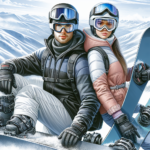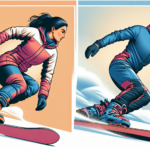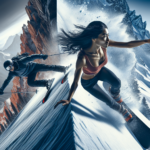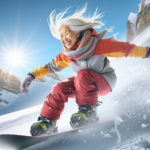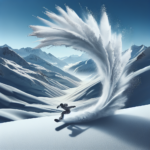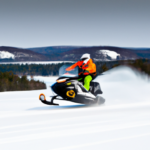Ever thought of embracing the chilly winter weather by hopping on a snowboard and gliding down the slopes? If so, you might also have wondered: does snowboarding hurt? Of course, like any sport or physical activity, there’s always a chance of bumps, falls, and potential injuries. The following article seeks to give you a detailed analysis of the potential risks and rewards of this popular winter activity. Equipped with this knowledge, you’ll be able to make an informed decision about whether to give snowboarding a try.
The Nature of Snowboarding
Snowboarding is a thrilling winter sport that combines elements of surfing, skateboarding, and skiing. It involves descending a snow-covered slope on a single board attached to your boots, using shifts in body weight to steer. The beauty of snowboarding lies in its combination of exhilarating speed, graceful maneuvers, and the breathtaking landscape of snow-clad mountains. Now, let’s delve a bit further into what snowboarding really involves.
Understanding What Snowboarding Involves
Snowboarding may look straightforward, but it involves more than just sliding down a hill. It’s about maintaining balance, controlling speed, and making turns on varied terrain. Not to mention the jumps, spins, and flips that come with more advanced techniques. Essentially, it’s a full-body workout that requires strength, agility, flexibility, and mental alertness. Plus, you’ve got to brace yourself for the weather conditions, which can change quickly on the mountainside.
Physical Requirements for Snowboarding
Given its full-body engagement, snowboarding requires a certain level of physical fitness. It demands core strength to maintain balance, leg power to steer and control the board, and arm strength for poles in certain styles. Cardiovascular stamina is also important as snowboarding can be quite exhausting, especially at higher altitudes where the air is thin. Flexibility is key to performing tricks and preventing muscle strains.
Risks Associated with Snowboarding
While snowboarding is an exciting sport, it’s not without its risks. Injuries can result from falls, collisions, or incorrect use of equipment. Other risks include exposure to harsh weather and the possibility of avalanches in backcountry snowboarding. It’s important to note that these risks can be significantly mitigated with proper training, equipment, and adherence to safety rules.
Potential Physical Hurt and Injuries in Snowboarding
Being aware of the potential injuries and understanding how to prevent them is crucial in any sport. This applies to snowboarding as well, where falling is quite common, especially for beginners.
Common Types of Injuries in Snowboarding
Frequent injuries include wrist, shoulder and ankle sprains, knee injuries, and bruises or cuts. More serious injuries can include fractures, dislocations, and concussions. Injuries most often occur during falls when snowboarders attempt to break a fall with their hands or when an awkward landing leads to a twist or sprain.
Why These Injuries Occur
Injuries happen for a variety of reasons ranging from incorrect technique, lack of control, or simply bad luck. A common cause of injury is falling over, especially for beginners who are still learning to balance. Other causes include attempting tricks beyond one’s skill level, or colliding with other skiers or snowboarders.
Preventative Measures against Injuries
Preventing injuries primarily involves learning correct techniques, being aware of your surroundings, and wearing protection. Helmets can protect against head injuries, wrist guards can mitigate wrist sprains, and hip pads can shield from tailbone injuries. Always remember to warm up before a run to prepare your muscles and stretch after to cool down.
The Impact of Snowboarding on your Muscles
Snowboarding is a fantastic full-body workout. However, it’s also quite challenging and can put considerable strain on your muscles.
The Major Muscles Used in Snowboarding
Snowboarding works out various muscles in the body. The quads and hamstrings are vital for maintaining a squat-like position while riding. The core – particularly the abs and lower back – aids in balance and turning motion. The calf muscles and the muscles around the ankles are important for controlling the board.
Potential Strains and Overuse Injuries
With every sudden turn, jump and stop, the muscles in your legs, core, and even your upper body work overtime. This constant strain can lead to overuse injuries, including muscle strains and tears. It’s especially common to get lower-body injuries, as your knees and ankles absorb the brunt of the impact with the snow.
Ways to Prepare Your Muscles for Snowboarding
Conditioning your body for snowboarding can help prevent strains and overuse injuries. Your training should focus on strengthening your core, legs, and balance. Practices like squats, lunges, planks, and yoga can be very useful. Remember, the fitter you are, the more endurance you will have on the slopes, which reduces the injury risk.
Does Snowboarding Hurt your Knees?
Snowboarding can be quite tough on your knees due to the constant bending, twisting, and absorbance of bumps and jumps.
Why Snowboarding Can Be Hard On Your Knees
While snowboarding, your knees constantly absorb the shocks and jolts from the board and the snow. Additionally, the twisting motion required for turns can strain the ligaments. Over time, this wear and tear can lead to discomfort or injury.
Types of Knee Injuries from Snowboarding
Common knee issues among snowboarders include sprains of the anterior cruciate ligament (ACL) or the medial collateral ligament (MCL), meniscus tears, and patellar fractures. These injuries typically occur when a turn or landing goes wrong, or when there is a collision.
Ways to Safeguard Your Knees When Snowboarding
Good knee health while snowboarding starts with strengthening the muscles around them, particularly the quads, hamstrings, and calf muscles. Wearing knee pads or braces can add a layer of protection. It’s also essential to learn correct techniques that minimize knee strain.
The Impact of Falls in Snowboarding
Falling is a part and parcel of snowboarding. It’s also the most common cause of injuries. Being aware of how falls impact your body can help you prepare better.
How Often Falls Occur in Snowboarding
Falls happen quite often in snowboarding, especially when you’re still learning. Even experienced snowboarders fall occasionally, particularly when attempting new tricks or riding in challenging conditions. The severity and impact of these falls can vary greatly.
Common Injuries from Falls
When you take a tumble, you often instinctively try to break your fall with your hands, which can lead to wrist sprains and fractures. Head injuries can occur if you hit the ground hard. Shoulder sprains or dislocations can result from an awkward landing.
Preventing and Mitigating Falls When Snowboarding
Wearing the correct protection can significantly reduce the risks from falls. This includes helmets, knee and elbow pads, and wrist guards. Learning to react correctly when you fall is just as important as minimizing the chances of falling. This includes knowing how to roll during a fall to distribute the impact and not trying to break the fall with your hands.
Does Snowboarding Hurt your Back?
The nature of snowboarding movement, combined with the potential for falls, can lead to various back-related aches and injuries.
Why Snowboarding Can Lead to Back Discomfort or Injury
The constant twists, turns and bends necessary for snowboarding puts a lot of stress on your back. Falls can further contribute to back discomfort or injuries.
Common Types of Back Pain from Snowboarding
Common complaints range from muscle strains and sprains to more serious conditions like herniated discs and fractures. Back pain can also be a result of overuse or lack of conditioning.
Effective Ways to Protect Your Back When Snowboarding
Regular core strengthening exercises, yoga, and stretching can greatly help to protect your back. Warming up properly before starting and cooling down after your session can also reduce the risk of back injuries. Proper technique and posture are important to reduce strain on your back.
Does Snowboarding Hurt Your Ankles?
Ankles, much like knees, also bear quite a brunt of the impact in snowboarding. Let’s look at why and how you can protect your ankles.
Why Ankles Can Be Affected by Snowboarding
Your ankles play a crucial role in steering the snowboard and absorbing shock from jumps and bumps. All these activities put strain on your ankle joints and the surrounding muscles and ligaments.
Types of Ankle Injuries Common to Snowboarding
The ankle injuries you can get from snowboarding include sprains, strains, and fractures. Snowboarder’s ankle – a specific kind of fracture of the talus bone – is a unique injury to this sport.
How to Protect Your Ankles from Snowboarding Injuries
Wear the right footwear that provides sufficient ankle support. Regular conditioning exercises like calf raises and ankle rolls can help strengthen your ankles. Avoiding overly aggressive turns and jumps can prevent excessive strain on the ankles.
Addressing Fears and Anxiety about Pain in Snowboarding
Despite your best efforts, falls and minor injuries are a part of snowboarding. This can cause a certain degree of apprehension, but there are ways to overcome it.
The Psychological Aspect of Pain in Physical Activity
It’s entirely natural and quite common to fear injury when participating in a sport like snowboarding. Be mindful of your body’s signals, but try not to let fear inhibit your learning or performance.
Overcoming Fear of Injury or Hurt in Snowboarding
Focus on improving your skills, staying fit, and using the right equipment. The confidence from knowing that you are taking all possible precautions can help abate fear. Understanding and accepting that minor injuries may occur is also important.
Turning Negative Apprehension into Positive Anticipation
To manage your fear, focus on the positive aspects of snowboarding – the thrill of descending a slope, the satisfaction of mastering a new trick, or the beauty of the snowy landscape. Turning fear into excitement or anticipation is a way of reassessing the situation positively.
Pain Management and Recovery from Snowboarding Injuries
Pain management and recovery from injuries are as important as prevention strategies.
Effective Pain Management Strategies for Snowboarding Injuries
Appropriate rest, using over-the-counter pain-relievers, and applying ice to injured areas can help manage minor pains and injuries. Listening to your body, knowing when to push through the discomfort and when to stop and rest, is a crucial part of pain management.
The Importance of Rest and Recovery in Dealing with Pain
Taking ample rest is vital in recovering from any injury. A good night’s sleep, taking easy days, and rest periods between hard sessions give your body time to heal and rebuild.
When to Seek Medical Attention for Snowboarding Injuries
For severe or persistent discomfort, or any significant injury, it’s important to seek professional medical attention. Take any head, neck, or back injury very seriously. Don’t try to ‘tough it out’ – it can lead to further damage.
How Proper Training Can Reduce the Risk of Hurt in Snowboarding
Proper training goes a long way in preventing injuries and reducing pain. It equips you with the necessary techniques and skills to handle different situations on the slope.
The Role of Conditioning in Preventing Snowboarding Injuries
Regular physical conditioning is essential to prepare your body for the demands of snowboarding. Exercises that build strength, balance, and flexibility can considerably reduce the risk of injuries.
The Benefits of Professional Snowboarding Instructions
Professional instructors can correct your technique, provide useful tips, and guide you to handle various terrains and weather conditions. This helps you avoid common mistakes that could lead to injuries.
Snowboarding Techniques That Can Help Minimize Hurt
Mastering certain techniques can help you reduce the chance of hurt. For instance, knowing how to fall correctly, maintaining the proper body position while riding and landing, and pacing yourself can all reduce injury risk.
To conclude, while snowboarding can result in occasional aches and injuries, most of these can be managed and reduced with the right understanding, precautions, and techniques. Always remember, safety first!
- What Snowboard Bindings Should I Get? - January 23, 2024
- What Size Screws For Snowboard Bindings? - January 23, 2024
- How To Snowmobile On Water? - January 23, 2024

